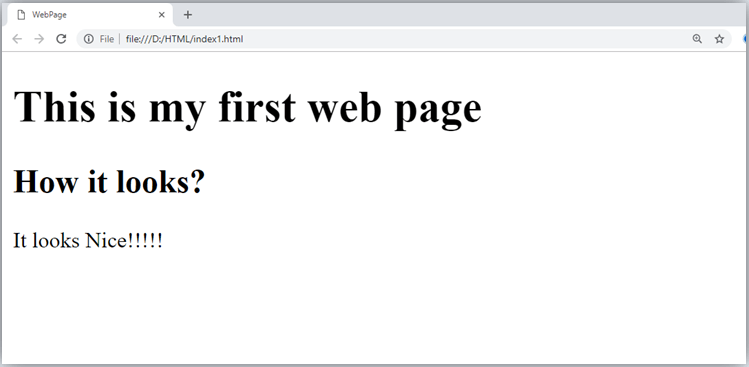HTML ElementsAn HTML file is made of elements. These elements are responsible for creating web pages and define content in that webpage. An element in HTML usually consist of a start tag <tag name>, close tag </tag name> and content inserted between them. Technically, an element is a collection of start tag, attributes, end tag, content between them. Note: Some elements does not have end tag and content, these elements are termed as empty elements or self-closing element or void elements.Such as: ExampleTest it Now
Void element: All the elements in HTML do not require to have start tag and end tag, some elements does not have content and end tag such elements are known as Void elements or empty elements. These elements are also called as unpaired tag. Some Void elements are <br> (represents a line break) , <hr>(represents a horizontal line), etc. Nested HTML Elements: HTML can be nested, which means an element can contain another element. Block-level and Inline HTML elementsFor the default display and styling purpose in HTML, all the elements are divided into two categories:
Block-level element:
Following are the block-level elements in HTML. <address>, <article>, <aside>, <blockquote>, <canvas>, <dd>, <div>, <dl>, <dt>, <fieldset>, <figcaption>, <figure>, <footer>, <form>, <h1>-<h6>, <header>, <hr>, <li>, <main>, <nav>, <noscript>, <ol>, <output>, <p>, <pre>, <section>, <table>, <tfoot>, <ul> and <video>. Note: All these elements are described in later chapters.Example:Test it NowOutput: 
In the above example we have used tag, which defines a section in a web page, and takes full width of page.
We have used style attribute which is used to styling the HTML content, and the background color are showing that it's a block level element. Inline elements:
<a>, <abbr>, <acronym>, <b>, <bdo>, <big>, <br>, <button>, <cite>, <code>, <dfn>, <em>, <i>, <img>, <input>, <kbd>, <label>, <map>, <object>, <q>, <samp>, <script>, <select>, <small>, <span>, <strong>, <sub>, <sup>, <textarea>, <time>, <tt>, <var>. Example:Test it NowOutput: 
Following is the list of the some main elements used in HTML:
Next TopicHTML Formatting
|
 For Videos Join Our Youtube Channel: Join Now
For Videos Join Our Youtube Channel: Join Now
Feedback
- Send your Feedback to [email protected]
Help Others, Please Share










